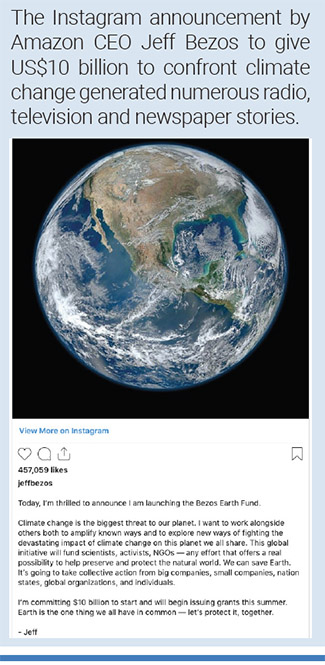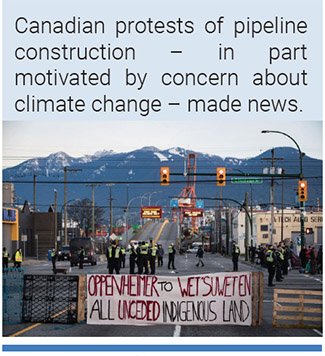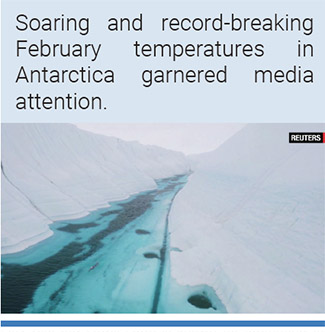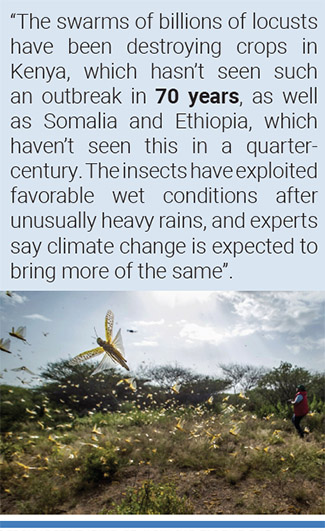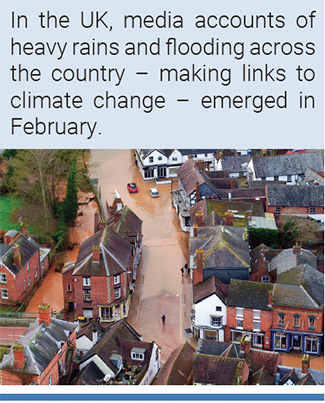Monthly Summaries
Issue 38, February 2020
[DOI]
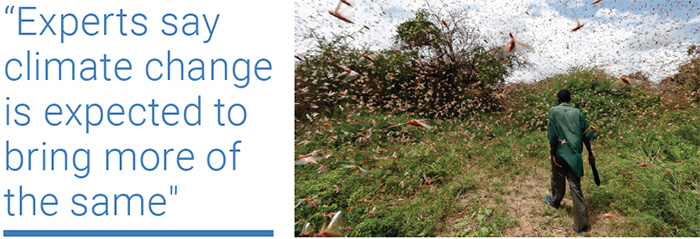
A man walks through a swarm of desert locusts near Kitui county, east of Nairobi, Kenya. Photo: Dai Kurokawa/EPA.

February media attention to climate change and global warming at the global level decreased 12% from January 2020 coverage, but was up 62% from the previous February 2019. Regionally, stories in February 2020 increased in North America (up 6%) from January 2020. Meanwhile, coverage decreased in all other regions in February 2020 compared to the previous month. Yet, there were increases in coverage in all regions except Africa (down 15%) in February 2020 compared to February 2019, with coverage increasing most in Oceania (up 53%) and in North America (up 81%). Figure 1 shows trends in newspaper media coverage at the global scale – organized into seven geographical regions around the world – from January 2004 through February 2020.

Figure 1. Newspaper media coverage of climate change or global warming in one-hundred print sources in seven different regions around the world, from January 2004 through February 2020.
New this month are regional figures across Africa (15 sources), Asia (23 sources), Europe (33 sources), Latin America (12 sources), the Middle East (6 sources), North America (20 sources) and Oceania (8 sources). We now track media coverage of climate change or global warming in ten languages:
- English: ‘climate change’ or ‘global warming’
- French: ‘changement climatique’ or ‘réchauffement climatique’
- German: ‘klimawandel’ or ‘globale erwärmung’
- Italian: ‘cambiamenti climatici’ or ‘riscaldamento globale’
- Japanese: ‘温暖化’ or ‘気候変動’
- Norwegian: ‘global oppvarming’ or ‘klimaendring’
- Portuguese: ‘mudanças climáticas’ or ‘aquecimento global’
- Russian: ‘изменен климат’ or ‘глобальн потеплен’
- Spanish: ‘cambio climático’ or ‘calentamiento global’
- Swedish: ‘global uppvärmning’ or ‘klimatförändring’

Figure 2. January 2004 – February 2020 newspaper coverage of climate change or global warming in 14 African newspapers: Business Day (South Africa), Ghanaian Chronicle (Ghana), The Herald (Harare Zimbabwe), Daily Trust (Nigeria), Vanguard (Nigeria), The New Times (Rwanda), Daily Nation (Kenya), The Times of Zambia (Zambia), New Era Nimibia (Namibia), The Citizen (Tanzania), Le Potentiel (Congo), L’Observateur Paalga (Burkina Faso), La Nouvelle (Morocco), Sud Quotidien (Senegal).
At the national-level, coverage in February 2020 generally declined slightly from January 2020 in the twelve nations where we specifically monitor country coverage (among 55 countries total). The exceptions in February 2020 were Canada (up 47%), United States (US) television (up 6%) and Russia (up 13%) compared to the previous month’s coverage in January 2020. Of note, thanks to the work of colleagues Gabi Mocatta and Erin Hawley from the University of Tasmania, we at MeCCO have begun to monitor four print sources in Russia from January 2000 – February 2020: Izvestiya, Rossiskaya Gazeta, Nezavisimaya Gazeta, and Komsomolskaya Pravda.

Figure 3. Map depicting sources by country and region monitored by MeCCO.
|
In February, political and economic content dominated media coverage. Among numerous stories, corporations’ declarations to move to carbon neutrality grabbed media attention. Among them, British Petroleum (BP) declarations to offset their emissions was a counter-intuitive story that earned news considerations and scrutiny. For example, Wall Street Journal reporters David Hodari and Adriano Marchese wrote, “BP PLC pledged to reduce its net carbon emissions to zero by 2050 and restructure its oil-focused businesses to better navigate a transition to other fuels—a dramatic, if vague, promise by one of the world’s biggest energy companies amid investor and consumer pressure over fossil fuels. The goal is the latest in a series of commitments, made over decades, by big oil companies to reduce emissions. While bold in ambition, BP didn’t provide details about how it expects to accomplish the goal, or how much it will cost”. New York Times journalist Brad Plumer reported, “the pledge is another sign that major companies, including fossil-fuel producers, are facing growing pressure from investors and activists to show they are taking global warming seriously... Rising concerns about climate change pose an existential threat for oil and gas companies, since scientists have said that preventing dangerous temperature increases will require steep reductions in the use of fossil fuels. In recent years, shareholders have pressed oil companies to prepare for a future in which countries shift to electric vehicles or enact new regulations to limit carbon dioxide emissions”.
|
Meanwhile, the February Instagram announcement by Amazon CEO Jeff Bezos to give US$10 billion to confront climate change generated numerous radio, television and newspaper stories. For example, CNBC journalist Thomas Franck wrote, “Amazon founder and CEO Jeff Bezos on Monday announced the launch of a new Earth Fund that the e-commerce chief plans to use to combat the effects of climate change. He said in an Instagram post that he’s pledging $10 billion to start the fund, which will be called the Bezos Earth Fund, and will issue grants to scientists, activists and other organizations in their efforts to “preserve and protect the natural world.” “We can save Earth,” Bezos wrote in his post. “It’s going to take collective action from big companies, small companies, nation states, global organizations, and individuals.” “Climate change is the biggest threat to our planet,” he added. “I want to work alongside others both to amplify known ways and to explore new ways of fighting the devastating impact of climate change on this planet we all share.” Bezos added in his post that he expects the Earth Fund to begin issuing grants to climate-oriented causes as soon as this summer”. Concern, suspicion and critique proliferated as well. For example, journalist Amy Held from US National Public Radio reported, “some Amazon workers, deeply critical of their employer's own environmental record, say it is Amazon itself that has been complicit in the climate crisis and must change its ways. "We applaud Jeff Bezos' philanthropy, but one hand cannot give what the other is taking away," Amazon Employees For Climate Justice said in a statement in response to the pledge. "When is Amazon going to stop helping oil & gas companies ravage Earth with still more oil and gas wells? When is Amazon going to stop funding climate-denying think tanks like the Competitive Enterprise Institute and climate-delaying policy? When will Amazon take responsibility for the lungs of children near its warehouses by moving from diesel to all-electric trucking?" In April, thousands of Amazon workers signed an open letter to Bezos and Amazon's board of directors, calling on them to end contracts with oil and gas companies, halt donations to climate change-denying lawmakers and setting measurable goals”.
Also in February, stories of United Kingdom (UK) preparations for the United Nations Conference of Parties meeting on climate change earned media attention. For example, early in February journalist Jill Lawless from The Associated Press reported, “Britain announced Tuesday that it plans to ban the sale of new gas and diesel cars by 2035 — five years earlier than its previous target — in a bid to speed up efforts to tackle climate change. The announcement was timed to coincide with the launch of Britain’s plans for the United Nations’ climate summit, known as COP26, which is scheduled to be held in Glasgow in November. But the U.K. government’s commitment to reducing greenhouse gas emissions was questioned by the woman who was appointed by Prime Minister Boris Johnson to head the Glasgow climate summit — and then was fired last week”. Moreover, longtime BBC journalist Roger Harrabin noted, “The UK is hosting COP26 in Glasgow in November - but Boris Johnson sacked president Claire O’Neill on Friday. Mrs O'Neill told the BBC there was a "huge lack of leadership and engagement" from the government. But senior cabinet minister Michael Gove said Mr Johnson was dedicated to environmental issues. Mr Gove told BBC Radio 5 Live that the prime minister described his political outlook as that of a "green Tory" when they first met 30 years ago. "Ever since then I've seen his dedication to ensuring that we fight to ensure that our Earth is handed on in a better state to the next generation," he said. But Ms O'Neill, the former Conservative minister for energy and clean growth, said people should be wary of the prime minister's promises. "My advice to anybody to whom Boris is making promises - whether it is voters, world leaders, ministers, employees, or indeed family members - is to get it in writing, get a lawyer to look at it and make sure the money's in the bank," she told BBC Radio 4's Today programme”.
Police officers clearing protesters that were blocking an entrance during a demonstration in solidarity with Wet'suwet'en hereditary chiefs opposed to construction of a natural gas pipeline across their traditional territories, in Vancouver, on February 10, 2020. Photo: Darryl Dyck/The Canadian Press. |
In February, cultural dimensions about climate change and global warming earned media coverage. For example, Canadian protests of pipeline construction – in part motivated by concern about climate change – made news. For example, Globe & Mail journalists Brent Jang and Wendy Stueck reported, “A Wet’suwet’en Nation hereditary chief leading the opposition to the construction of a B.C. pipeline has been arrested, along with dozens of others who have been protesting across Canada in solidarity with her cause. Port workers in Vancouver, railway staff in Ontario and travellers along a highway on Vancouver Island faced disruptions on Monday. Arrests mounted, including people apprehended by police in Vancouver and near Houston, B.C. RCMP arrested Freda Huson, who has been at the forefront of a campaign to prevent Coastal GasLink’s $6.6-billion pipeline from being built in territory claimed by the Wet’suwet’en, enforcing a B.C. court injunction. Ms. Huson was among the people arrested on Monday near a crucial bridge crossing. She backs Wet’suwet’en hereditary house chiefs who are fighting Coastal GasLink’s plans to transport natural gas from northeastern British Columbia to Kitimat on the coast. Coastal GasLink has said in court documents that Ms. Huson, who received the hereditary wing-chief (subchief) name Howihkat last year, is one of the two architects behind the Unist’ot’en camp that opposes the pipeline. Unist’ot’en is affiliated with Dark House, one of 13 Wet’suwet’en hereditary house groups. Lawyers for Coastal GasLink say Ms. Huson and Warner Naziel are the co-founders of the Unist’ot’en camp, which was set up in 2010 to block pipelines through the Wet’suwet’en’s unceded traditional territory. By 2015, the camp had expanded to include a healing lodge”. Adding further context, New York Times journalist Ian Austen noted, “The Canadian police on Monday began moving against protesters who had set up transportation blockades around the country in sympathy with an Indigenous group’s campaign to halt construction of a natural gas pipeline to Canada’s West Coast. The blockades affected at least 19,500 rail passengers, according to Via Rail Canada, and 200 freight trains were unable to travel... Protesters also effectively ended operations at major ports in Vancouver and nearby Delta, British Columbia; shut down a commuter railway line in Montreal; and blocked traffic in Regina, Saskatchewan. A small group also occupied an area outside the Ottawa office of Canada’s justice minister”.
Fifty-year-old Lewis Pugh is known for swimming in Arctic water to raise awareness for climate change. Source: Reuters. |
In February, ecological and meteorological connections with climate issues contributed to media coverage of climate change from Antarctica to the UK. To begin, soaring and record-breaking February temperatures in Antarctica garnered media attention. CNN journalist Drew Kann reported, “The hottest temperature ever recorded in Antarctica was measured on Thursday at a remote station on the continent's Northern tip, scientists said. The temperature was nearly 65 degrees Fahrenheit (18.3 Celsius) at Argentina's Esperanza research station, scientists from the country's meteorological agency said. That surpassed the previous record of 63.5 degrees Fahrenheit (17.5 Celsius) set on March 24, 2015 at the same location. Temperature records from Esperanza date back to 1961. This means that the temperature at Esperanza was practically identical to what was felt Thursday afternoon in San Diego, California. To be fair, it is summer in the Southern Hemisphere. But it's not typical that the temperatures in Antarctica -- one of the coldest places on Earth -- are nearly the same as those in Southern California”. Meanwhile, United States (US) National Public Radio journalist Colin Dwyer observed, “It's important to note that Thursday's finding is just one data point, the result of particular weather conditions that day on the northern Antarctic Peninsula. But... the positively balmy weather this week does match up with broader changes to the climate over time, both on the peninsula and globally. Last year was the world's second hottest year on record, and it just capped Earth's hottest decade ever recorded”.
Desert locusts jump up from the ground and fly away as a cameraman walks past in Nasuulu Conservancy, Kenya on February 1, 2020. Photo: Ben Curtis/AP. |
As another illustration, many stories covered outbreaks of desert locusts in East Africa as they made connections to a changing climate. The Guardian Africa correspondent Jason Burke reported, “Massive swarms of locusts sweeping across much of east Africa have reached Uganda and Tanzania, the United Nations has said, threatening millions more people with hunger in an already fragile region. Tanzania has detected swarms in its northern border areas close to Mount Kilimanjaro and hired three planes to spray pesticide, a tactic seen as the most effective means of countering the spread of the insects. Ugandan authorities have rushed pesticides to affected areas and has mobilised thousands of troops... The outbreak in east Africa is the most serious in decades and has already devastated crops across a swath of Kenya and Somalia. Climate experts have pointed to unusually heavy rains, aided by a powerful cyclone off Somalia in December, as a major factor in the crisis. The locusts arrived from the Arabian peninsula after cyclones dumped vast amounts of rain in the deserts of Oman – creating perfect breeding conditions”. Meanwhile, journalist Cara Anna from The Associated Press noted, “The swarms of billions of locusts have been destroying crops in Kenya, which hasn’t seen such an outbreak in 70 years, as well as Somalia and Ethiopia, which haven’t seen this in a quarter-century. The insects have exploited favorable wet conditions after unusually heavy rains, and experts say climate change is expected to bring more of the same ”.
Meanwhile, as threats from Australian bushfires receded, media accounts documented and reflected on their relationships to climate change. For example, in an article entitled ‘Droughts, Fire, Deluge: Climate’s Multiplier Effect Pounds Australia’, New York Times journalist Damien Cave reported, “Australia’s hellish fire season has eased, but its people are facing more than a single crisis. With floods destroying homes not far from where infernos recently raged, they are confronting a cycle of what scientists call “compound extremes”: one climate disaster intensifying the next. Warmer temperatures do more than just dry out the land. They also heat up the atmosphere, which means clouds hold more moisture for longer periods of time. So droughts get worse, giving way to fires, then to crushing rains that the land is too dry to absorb. One result of that multiplier effect for Australia — a global bellwether for climate change’s effects — is that rebuilding after a disaster becomes far more complicated. Many Australians in disaster zones complain that their government, after dismissing climate change for years, has yet to outline recovery plans that are clear and that take future threats into account”. In this piece, Cave also noted that Climate Council study found that property losses in Australia related to climate change could reach $384 billion by the end of this decade.
Tenbury Wells, England, on February 17, 2020. Serious flooding is becoming a more frequent reality in Britain, experts say. Photo: Steve Parsons/Press Association. |
And in the UK, media accounts of heavy rains and flooding across the country – making links to climate change – emerged in February. New York Times journalist Megan Specia reported, “Prime Minister Boris Johnson’s response to a storm that battered the country over the weekend, causing severe flooding in hundreds of towns and villages, prompted a backlash from critics inside and outside his party on Monday. Mr. Johnson came under fire on Monday after his office said that he had no plans to visit any of the flooded areas after Storm Dennis... The storm dumped more than half a month’s worth of rainfall in one day in some areas. Rivers overflowed their banks, sending water several feet deep through streets, houses and businesses, forcing many people to leave their homes and cutting some communities off from relief efforts. Some areas were still recovering from heavy rains and strong winds brought by another storm just a week earlier... Serious flooding is becoming a more frequent reality in Britain due to global warming, experts say”. Furthermore, reporter Jeff Berardelli from CBS News commented, “One of the strongest storms in modern history is pummeling the North Atlantic and western Europe with massive waves and hurricane force winds. The system's name is Dennis and it comes less than a week after storm Ciara helped power a British Airways flight to a new trans-Atlantic speed record over 800 mph. Dennis is massive, spanning more than 3,000 miles in width from eastern Canada to Scandinavia. The behemoth's pressure dropped to 920 millibars near Iceland this weekend, on par with the most intense hurricanes including Hurricane Maria in 2017 and Hurricane Katrina in 2005. The lower the millibars — a measure of atmospheric pressure — the stronger the storm, and Dennis' barometric pressure is just 7 millibars short of the record-strongest North Atlantic non-tropical storm from 1993”.
Finally, media accounts in February focused on scientific themes as well. For example, new research about changing ocean currents due to a changing climate were picked up in numerous news organizations. Among them, Washington Post journalist Chris Mooney reported, “Three-quarters of the world’s ocean waters have sped up their pace in recent decades, scientists reported Wednesday, a massive development that was not expected to occur until climate warming became much more advanced. The change is being driven by faster winds, which are adding more energy to the surface of the ocean. That, in turn, produces faster currents and an acceleration of ocean circulation. It’s the latest dramatic finding about the stark transformation of the global ocean — joining revelations about massive coral die-offs, upheaval to fisheries, ocean-driven melting of the Greenland and Antarctic ice sheets, increasingly intense ocean heat waves and accelerating sea level rise”.
We continue with our work monitoring and analyzing media coverage, now across 117 sources in 55 countries across planet Earth. We hope we continue to add value to connected efforts to sort through the unceasing flow of experience via media accounts of climate change and global warming.


